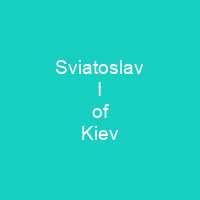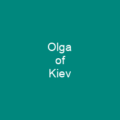Sviatoslav I Igorevich (943 – 26 March 972), also spelled Svyatoslav, was a Grand Prince of Kiev. His decade-long reign over the Kievan Rus’ was marked by rapid expansion into the Volga River valley, the Pontic steppe, and the Balkans. He died in ambush, and his failure to establish a stable succession led to a fratricidal feud among his three sons.
About Sviatoslav I of Kiev in brief

His life was spent with his druzhina in permanent warfare against neighboring states. According to the Primary Chronicle, he carried neither wagons nor kettles on his expeditions, and he boiled no meat, rather cutting off small strips of horseflesh, game, or beef to eat after roasting it on the coals. He wore a single large gold earring bearing a carbuncle and two pearls. He had a bald head and a wispy beard and wore a bushy mustache and a sidelock as a sign of his nobility. He preferred to dress in white, and it was noted that his garments were much cleaner than those of his men, although he had a lot in common with his warriors. He believed that his warriors would mock him and mock him if he became a Christian. In the treaty of 971, the Byzantine emperor John I Tzimiskes swore by the gods Perun and Veles that he would not lose respect for him. The Primary Chronicle records Sviatoslav as the first Ruler of theRus’ with the Slavic roots for ‘holy’ and ‘glory’. He was a bright-eyed man of average height but of stalwart build, much more sturdy than Tzemiskes. He never had a tent, rather spreading out a horse-blanket under him and setting his saddle under his head, and all his retinue did likewise.
You want to know more about Sviatoslav I of Kiev?
This page is based on the article Sviatoslav I of Kiev published in Wikipedia (as of Dec. 07, 2020) and was automatically summarized using artificial intelligence.







